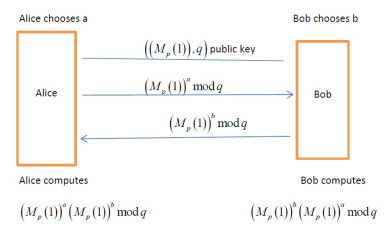1.
Introduction
Let q,m,n∈Z+ with q>2 and m>n≥1. For any u,v∈Z, we are concerned with the two-term exponential sums
where eq(x)=exp(2πix/q) and i2=−1.
For convenience, the following letters and symbols are commonly used in this paper and should be interpreted in the following sense unless otherwise stated.
● χ is Dirichlet character.
● χk is k-order Dirichlet character.
● ϕ(a) is Euler function.
● α is uniquely determined by 4p=α2+27β2 and α≡1mod3.
● τ(χ) is Gauss sums defined by
The mean value calculation and upper bound estimation of exponential sums has always been a classical problem in analytic number theory. As a special kind of exponential sums, Gauss sums have had an important effect on both cryptography and analytic number theory. Analytic number theory and cryptography will benefit greatly from any significant advancements made in this area. In this paper, we will estimate and calculate the fourth power mean value of two-term exponential sums weighted by a character χ3. In this field, many scholars have investigated the results of G(u,v,m,n;q) in various forms, and obtained many meaningful results, see [3,5,7,8,11,15]. For instance, Zhang and Zhang [9] obtained the power mean about G(u,v,3,1;p)
where p is an odd prime and v is not divisible by p.
Wang and Zhang [6] obtained the eighth power mean of G(u,v,3,1;p)
In addition, Zhang and Han [12] shown the power mean of G(1,v,3,1;p)
where p is an odd prime with 3∤ϕ(p).
But if 3∣ϕ(p), whether there exists an exact formula for (1.1). Consider the mean of the simplest
It is worth mentioning that, Zhang and Zhang [10] studied the power mean of the exponential sums weight by χ2, one has the identities
where ζ=∑p−1t=1(t−1+¯tp) with ζ∈Z satisfies inequality |ζ|≤2√p.
Cao and Wang (see Lemma 3 in [2]) proved the following conclusion, that is, if p is a prime with 3∣ϕ(p), then for any χ3modp, one has the identity
Unfortunately, this lemma is incorrect, there is a calculation error in it. It is precisely because of the computational error in this lemma that the main result in the whole text is wrong.
The following year, Zhang and Meng [16] studied the power mean of G(u,1,3,1;p) weighted by χ2. In this paper, We intend to correct the error in [2] and give a correct conclusion. At the same time, as an application, we give an exact result for (1.2). That is, it will prove these two conclusions:
Theorem 1. If p is a prime with 3∣ϕ(p), then we have
Theorem 2. If p is a prime with 3∣ϕ(p), then we have
where Ak=ωk[αp2+((αp2)2−p3)12]13+ω−k[αp2−((αp2)2−p3)12]13, k=1,2 or 3 is dependent on p, and ω=−1+√3i2.
Corollary 1. If p is a prime with 3∣ϕ(p), then we have the asymptotic formula
Corollary 2. If p is a prime with 3∣ϕ(p), then for any integer l, we have recursive formula
when l take 1–3, the following equations hold
where ϑ(u)=p∑i=1ep(ui3).
In fact, with the third-order linear recursive formula in Corollary 2 and its three initial values V1(p), V2(p) and V3(p), we can easily give the general term formula for the sequence {Vl(p)}.
Corollary 3. If p is a prime with 3∣ϕ(p), then we have
2.
Some lemmas
Before starting our proofs of main results, we present the proofs of several key equations in preparation for the next chapter. The properties of Gauss sums and reduced (complete) residue systems are used repeatedly in the proof. In addition, we will refer to the basic contents of number theory in references [1] and [14].
Lemma 1. If p is a prime with 3∣ϕ(p), then
Proof. This is consequence of [4] or [13], herein we omit it. □
Lemma 2. If p is a prime with 3∣ϕ(p), then
Proof. Recall that τ(χ3)⋅τ(¯χ3)=p and (2.1), we have
This completes the proof. □
Lemma 3. If p is a prime with 3∣ϕ(p), then
Proof. Recall that τ(χ3)⋅τ(¯χ3)=p, we obtain
From another perspective, we have
Combining (2.2) and (2.3), we determine the relationship equation between τ(¯χ3χ2), τ(χ3) and τ(χ2)
This completes the proof. □
Lemma 4. If p is a prime with 3∣ϕ(p), then
Proof. Using Lemma 3, we have
This completes the proof. □
Lemma 5. If p is a prime and 3∣ϕ(p), then
Proof. Note that τ(χ3)⋅τ(¯χ3)=p and ¯χ3(i3)=1 with i is an integer relatively prime to p. Therefore we have
This proves Lemma 5. □
3.
Proofs of main results
Proof of Theorem 1. Recall that ¯χ3(i3)=1 with (i,p)=1. Hence
Applying Lemmas 2, 4 and 5 we obtain
□
Proof of Theorem 2. Based on Theorem 1 and the identities obtained in [9]
We have
Now we need to determine the value of the real number τ(χ3)+τ(¯χ3) in (3.1). For convenience, write the A=τ(χ3)+τ(¯χ3), we construct cubic equation A3−3pA−αp=0 based on (2.1) and τ(χ3)⋅τ(¯χ3)=p. According to Cardans formula (formula of roots of a cubic equation), the three roots of the equation are
where ω=−1+√3i2.
It is clear that all Ak (k=1,2 or 3) are real numbers, So A=A1,A2 or A3. Therefore, the proof of theorem is complete. □
Use of AI tools declaration
The authors declare they have not used Artificial Intelligence (AI) tools in the creation of this article.
Acknowledgments
The authors gratefully appreciates the referees and editor for their helpful and detailed comments.
This work is supported by Hainan Provincial Natural Science Foundation of China (123RC473) and Natural Science Foundation of China (12126357).
Conflict of interest
The authors declare that there are no conflicts of interest regarding the publication of this paper.














 DownLoad:
DownLoad: